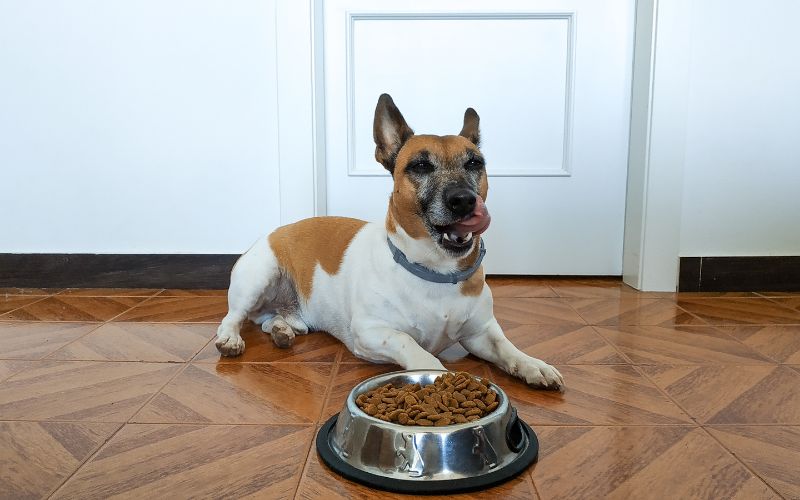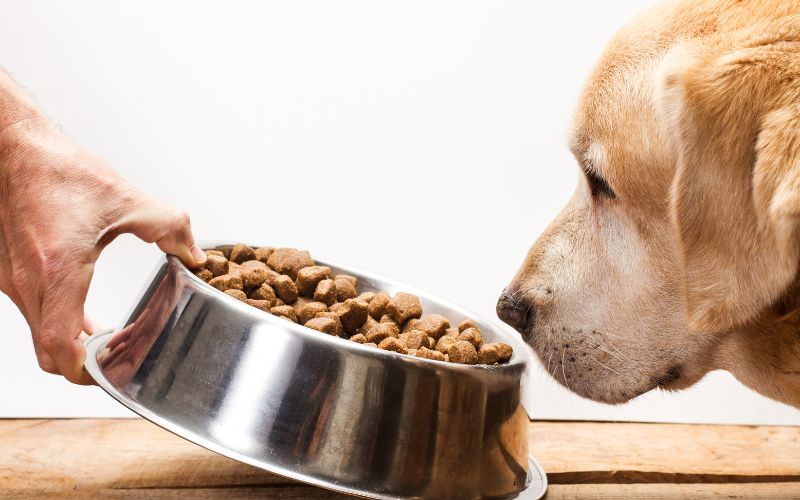As a dog owner, you know that it can be tough to get your dog to eat all her food.
Sometimes they’ll clean their bowl right up, but other times they’ll take their time and leave plenty behind.
This can be frustrating, especially if you’re trying to make sure your dog is getting the nutrition she needs.
In this post, we’ll share some tips on how to get your dog to eat all her food in one go.
Providing that your dog is fit and healthy the simplest way to get her to eat everything is to reduce her portion size and impose a time limit for her to empty her dish. Most dogs will eat all of their food within a few minutes so, if your dog leaves her dish with food still in it and has not cleared it within 10 minutes, remove the dish as this is the end of mealtime.
Why do dogs not eat all of their food?
There are several reasons why your dog may not be finishing her food.
One possibility is that she’s simply not hungry. Just like people, dogs’ appetites can vary from day to day.
If you think this might be the case, try giving your dog smaller meals more often throughout the day instead of one large meal.
Another possibility is that your dog is unwell and it is always a good idea to get her checked over by your vet if she continues to leave food.
Will a picky dog starve herself?
No. A dog’s body is designed to make sure they don’t starve themselves, even if they are picky eaters.
If your dog is leaving food in her bowl, it’s more likely that she’s just not that hungry or there’s something wrong with the food itself.

Tips for getting your dog to eat all her food
If you’re determined to get your dog to finish her food, there are a few things you can try.
First, check that the food you’re giving her is fresh and of good quality.
Dogs can be picky eaters, just like people, and if the food doesn’t look or smell appetizing, she’s not going to want to eat it.
Second, try serving her food at room temperature or slightly warmer.
Dogs have a much better sense of smell than people and warmer food will release more smells, making it more appealing to her.
Third, add some wet food or gravy to her dry food. This will make the food more aromatic and appetizing.
Fourth, try giving her smaller meals more often throughout the day instead of one large meal.
This will help to stimulate her appetite and make her hungrier when it’s time to eat.
Fifth, if she hasn’t finished her meal within a period of 10 to 15 minutes and she walks away from her dish, then take the dish away.
Mealtime is now officially over and she will soon get the idea.
Sixth, make sure she doesn’t have access to other food sources. If she’s getting food from somewhere else, she’s not going to be as interested in her bowl.
This includes things like dog treats, human food, the contents of the rubbish bin and anything else that she might find appetising.
Things that you should not do to get your dog to eat all her food
Do not free-feed your dog. This means leaving her bowl of food out all day for her to eat whenever she wants.
While this might sound like a good idea, it can actually lead to weight gain and other health problems.
Free-feeding also means that your dog is more likely to become a picky eater because she knows there will always be food available and she doesn’t have to eat it all in one go.
Do not use your dog’s food as a reward. This includes using it for training purposes or as a way to get her to do something that you want her to do.
This will only teach your dog that her food is not something to be eaten but something to be used as a bargaining tool.
Do not add human food to her bowl in an attempt to get her to eat it all.
This is only going to make her more choosy about what she eats and she’s likely to start begging for human food all the time.
Do not force your dog to eat her food. This will only make her anxious and stressed and she’s likely to develop a negative association with food.
Don’t make constant changes to your dog’s food. As tempting as it might seem to keep her diet varied, dogs do not need this variation.
In fact regular changes to your dog’s food can do more harm than good as, unlike people, dogs need time to adjust to different foods.
Constant changes can result in diarrhea, stomach upsets and other complaints.
When to see the vet
If your dog is leaving food in her bowl and you’re concerned that she might be starving herself, then it’s always best to talk to your vet.
There are a number of medical conditions that can cause a loss of appetite in dogs so it’s important to rule these out before assuming that your dog is just being fussy.
If your vet gives the all-clear then you can start to look at other reasons why your dog might not be finishing her food.
Remember, if you’re ever in doubt, always err on the side of caution and speak to your vet.
They will be able to advise you on the best course of action for your dog.
If your dog is leaving food in her bowl, there could be a number of reasons why.
Before assuming that she’s just being fussy, rule out any medical causes by speaking to your vet.
Once you’ve ruled out any underlying health problems, you can start to look at other reasons why your dog might not be finishing her food.
There are a number of things that you can do to try and encourage your dog to eat all of her food.
These include adding wet food or gravy to dry food, giving smaller meals more often, making sure she doesn’t have access to other food sources and taking away her bowl if she doesn’t eat within a set period of time.
There are also a number of things that you should not do, such as free-feeding, using food as a reward or making constant changes to her diet.
If you’re still struggling to get your dog to eat all of her food, then talk to your vet or a qualified behaviourist for further advice.




